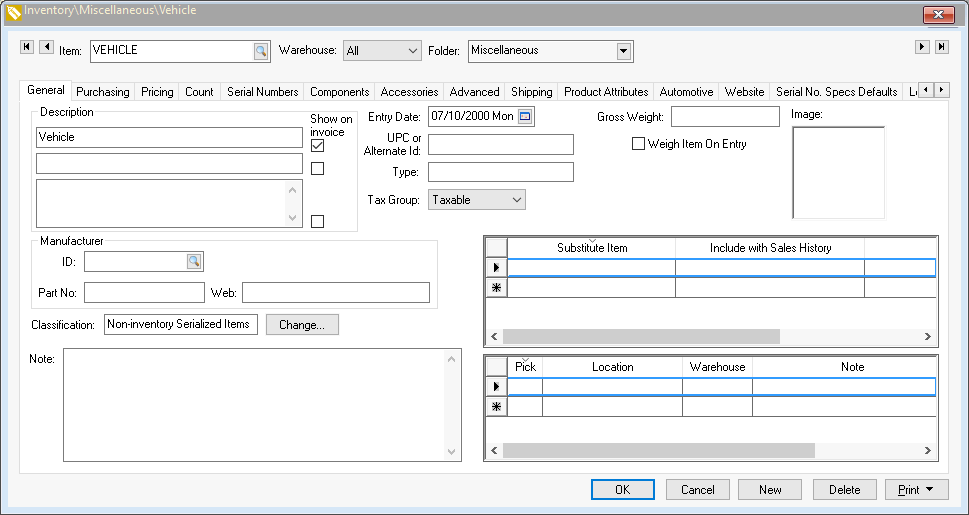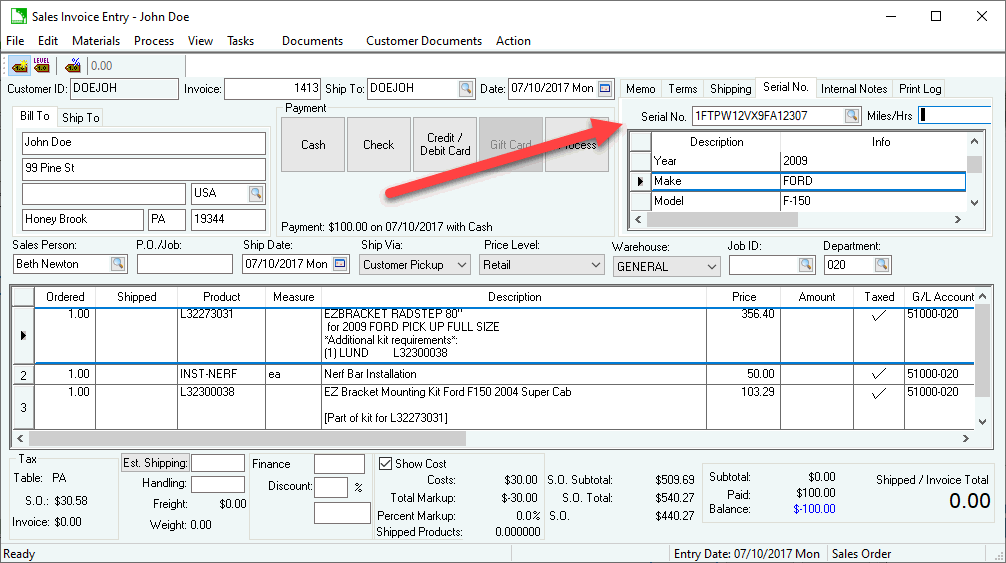Recording a Vehicle or Equipment by VIN Number
Create a Serialized Item | Record Customer Vehicles | Scenarios and Training Materials
A vehicle identification number (VIN) is a unique code given to each vehicle in the United States, including automobiles, trucks, and trailers. Many companies use the EBMS Serialized Item module to record VIN number as a serial number. VINs can be recorded to identify vehicles that are purchased and sold, used vehicles, or to identify the customer’s existing vehicle for service only. Work orders, sales invoices, and other history documents are associated with the customer’s vehicles creating a valuable reference for both the customer and the service technician.
The serialized item database which is used to track the serial number of equipment can also be used to track a customer’s vehicle information. This tool allows the user to track the work orders or invoices associated with a specific vehicle or equipment giving the user a history of the customer’s equipment. This option is used by many auto parts and accessories stores, vehicle service centers, truck up fitters, trailer sales and service companies, and other vehicle or large equipment sales and service companies.
Create Default Serialized Item
A generic inventory item needs to be created to identify the associated serialized item records as a vehicle VIN numbers. These serialized items/Vehicle VINs are used as service-only VINs unless vehicles with VINs are sold. Complete the following steps to create an inventory item that is used only to identify the serialized item as a vehicle.
-
Create a generic inventory item classified as a Non-Inventory Serialized Item as shown below. Note that most settings within the inventory item can be ignored. Review the Non-Inventory Serialized Item section for more details on creating this generic item.

-
Click on the Product Specs tab to enter the vehicle specs to download from NHTSA. Add the following spec Description that will be decoded from the VIN number. Enter the Year, Make, Model, and Engine specs as shown below since this standard information is needed for any vehicle.
-png.png?width=688&height=364&name=image%20(3)-png.png)
Add any additional vehicle specs to this tab, such as Wheel Size, cab type, trailer connection type, number of wheels, etc. Review the NHTSA Raw Data section of Vehicle Identification Number (VIN) Decoding for more detailed instructions. -
Record this generic non-inventory item within inventory options. Click Inventory > Options and click on the Serial No. Specs tab as shown below:

-
Enter the generic inventory item that was created in step #1. This entry is required to automate the VIN number entry within the sales order.
EBMS also contains the ability to decode the VIN number to list the vehicle's year, make, model, and copy the vehicle specifications from NHTSA | National Highway Traffic Safety Administration. Review the Vehicle Identification Number (VIN) Decoding section for more details.
An alternative stock number may be needed to identify a vehicle. Review the Alternative Serial Number section at the end of Serialized Item Overview for details.
Record Customer Vehicles
The Serialized Item tab of a customer record can be used to list any vehicles or equipment owned by each customer. This information is helpful when identifying a piece of equipment by customer for a work order or invoice. Vehicles can be added from the serialized item tab of the customer record, but the VIN decoder is not launched from this tab. Complete the following steps to add a customer's equipment or vehicle information, as well as the VIN decoding:
-
Open the sales order dialog by selecting Sales > New Sales Order from the main EBMS menu.
-
Populate the Customer ID to identify the owner of the vehicles.
-
Click on the Serial No. tab of the sales order as shown below:

-
Enter the vehicle’s VIN number into the Serial No. field. Entering a VIN number into the Serial No. entry will active the Vehicle Identification Number (VIN) Decoding.
-
Enter the optional Miles/Hrs value of the vehicle at the time of service.
-
Note that the vehicle's serial number specifications will be populated on the sales order.
Repeat for any additional vehicle for this customer. Note that vehicle information can also be added when service or parts are purchased. Review Viewing or Adding Service Only Items to a Customer for more details on adding serialized items to a customer record.
Repeat the steps list above for additional customers.
Review the Attaching a Vehicle to a Sales Invoice section for details on attaching a vehicle to EBMS documents.
Scenarios and Training Materials
Scenario: An automotive accessories dealer identifies the vehicle on a work order and sales invoice when billing aftermarket parts for customer fleets, trucks, and other vehicles. The vehicle product specs can identify the year, make, model, and other details of the dealer’s vehicles, company fleet vehicles, or customer vehicles. Sales staff can use these details to quickly identify the correct accessory for a customer’s specific vehicle. These VIN details are displayed on the work order allowing the technician to quickly identify the vehicle.